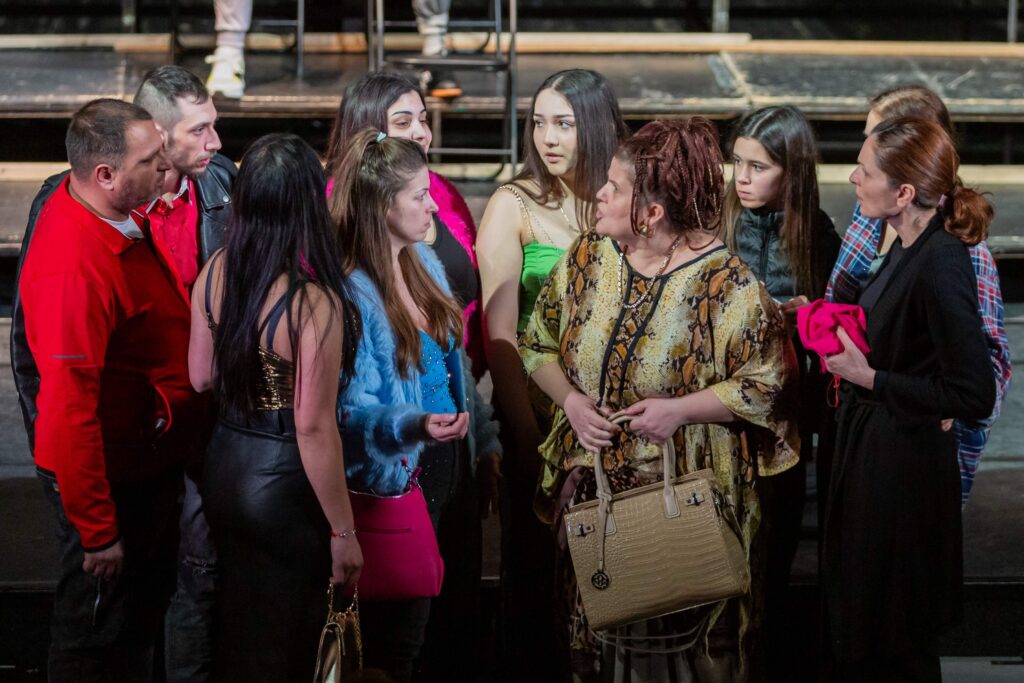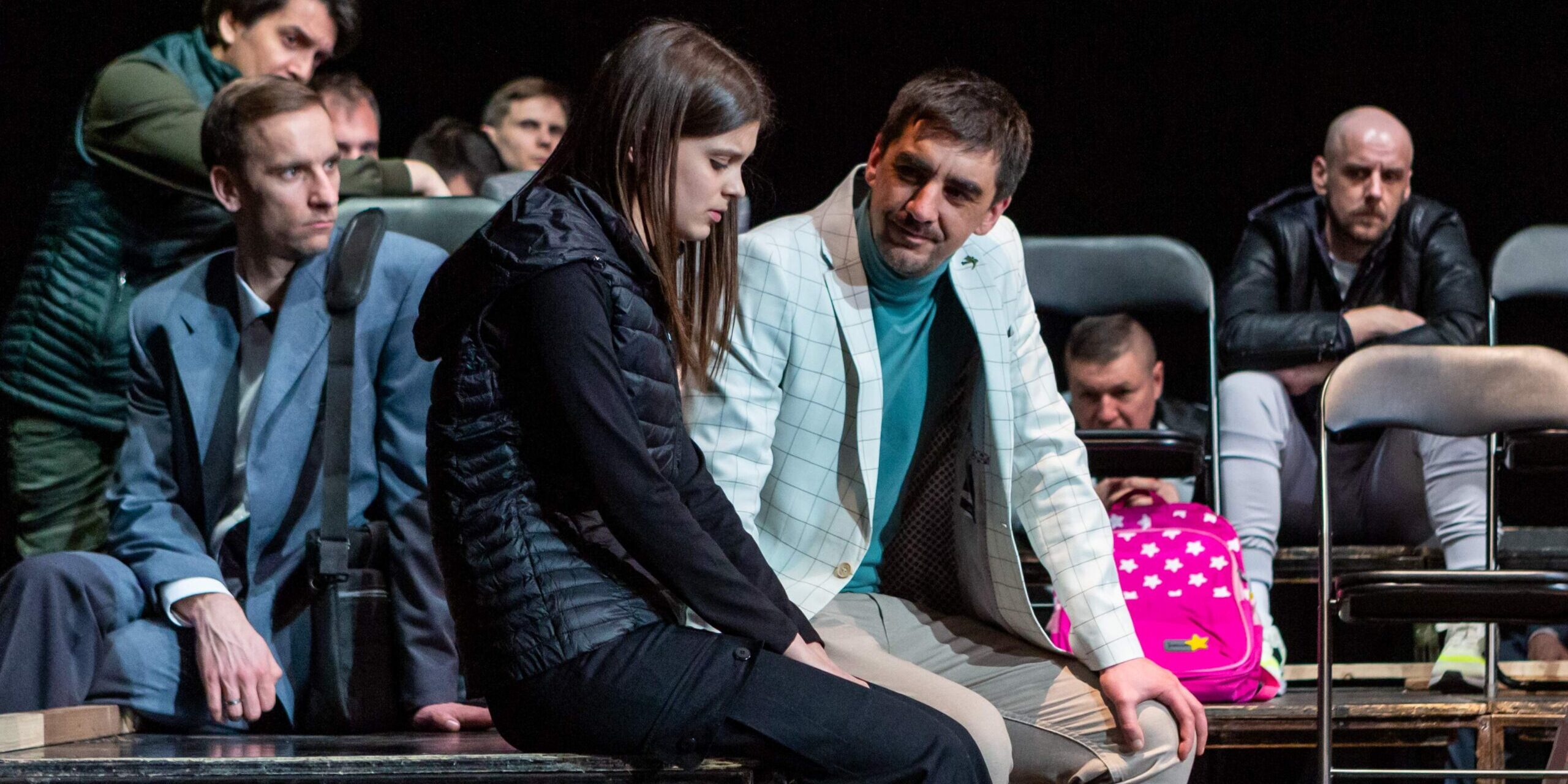Though written nearly 150 years ago, Albina Podgradska’s play Poor Mileva still feels timely. Duška Radosavljević Krojer talks to director Anđelka Nikolić about why rescuing the play from obscurity is a form of activism.
Imagine a play about migration, written in five languages, centring women, girls and the theme of empathy while at the same time sharply critiquing greed, oppression and loan-shark capitalism.
You might think I am talking about a 21st century play, but this text was actually written and published nearly 150 years ago by Albina Podgradska, a woman of Slovak heritage who at the time lived in a Serbian province of the Austro-Hungarian Empire and wrote in the Serbian language. Contemporary scholars believe this to be the first play written by a woman in Serbian ever published. Upon its publication, which coincided with the author’s unfortunate death at the age of 21 in 1880, the text promptly fell into obscurity and was never performed. Until now.
Premiering on 14th March at the National Theatre of Subotica, in co-production with the Children’s Theatre Subotica and the Village Cultural Centre Markovac, Poor Mileva from Bosnia in Our Civilisation in the Year 1878 is directed by Serbian director Anđelka Nikolić. Although seemingly specialising in breathing life into the long forgotten and never performed Serbian dramatic texts from the 19th century – for example, her production of Joakim Vujić’s The Blacks – which I wrote about here – Andjelka Nikolić does so, not just out of an interest in history, but out of activism.
Nikolić is a founder member of the Village Cultural Centre Markovac, a space dedicated to cultural decentralisation. Since 2019 the Centre has offered theatre workshops in a rural residential property and as of 2020 it also houses a library whose aim is ‘gender justice’:
This means – explains Nikolić – that when you enter and look through the bookshelves, you should see equal representation of male and female authors. “Besides, when you look inside the books, the text should be free of stereotypes regarding gender roles in society. When it comes to contemporary literature that’s more or less possible, but when you look at the history of literature then you can really see that for centuries men have had more possibility to think that they have something to say or write, and to write books that would then be published. But when it comes to writing for the theatre, the additional factor has been that every piece someone had written needed to be put on the stage. So the mission of this work is to revisit the past and give a chance to the authors who have been overlooked by the history of theatre and literature.”
Nikolić discovered Albina Podgradska thanks to the academic portal Knjiženstvo, which in addition to being a journal also has a page that taxonomizes all female writers who ever wrote in Serbian. In 2019, Nikolić wrote and published her own academic paper – an initiative also forming part of her activism – in which she compares the play Poor Mileva by Podgradska to a Serbian classic from a similar period The Patriots (1853) by Jovan Sterija Popović, one of the most performed plays in Serbian of all time. The main point of comparison is the fact that both plays are treating the topics of war displacement and cultural power struggles, but from distinct, mutually inverse positions. The Patriots operates from the traditional, inherently patriarchal position in which these matters are handled by men, whereas in Poor Mileva, the main protagonist is a teenage girl who, in one of the most dramatic scenes of this episodic play, pawns her favourite doll in order to get some money for her mother and their maid to survive.
In an academic article, which primarily investigates models of citizenship through its comparative analysis, Nikolić also highlights a scene of underage political engagement involving a group of schoolgirls who discuss their classmate Mileva’s predicament and organise themselves to agitate their parents to help the refugee family.
More intriguing dramaturgically, however, is the matter of language in the two plays. While Jovan Sterija Popović wrote his play in an ethno-centric way with all necessary quotations of Hungarian transliterated and Serbified for a local audience, Podgradska uses the five languages (Serbian, Hungarian, Polish, Slovak and Romani) in their authentic form, testifying to an unusual multimodality of perspectives at the foundation of her play.
“She really deploys a change of perspective,” says Nikolić. “She follows her characters and the logic of their communication; for example [she considers] which language might be used by two characters with different mother tongues who live or work in a shared environment. Consequently, as a writer she uses two methods. One is to write the dialogue in Romani or in Hungarian and to then provide the translation in footnotes. The other is a method of self-translation. For example there is one scene, which is very Beckett or Ionesco-like, in which a Hungarian man, a Slovak man and a Polish woman are talking in a Hungarian-Serbian-Slovak language and, because it is clear they do not all understand all of these languages, they would say something in one language and then translate it into another. But Albina was conscientiously footnoting everything and providing translation into Serbian, which she obviously treated as her literary language even though she was actually Slovakian.”

Poor Mileva, National Theatre Subotica
Nikolić’s production explores the theme of communication on a number of levels, including among different communities which constitute her 41-member intergenerational ensemble of professional, non-professional and multicultural performers; but also between the original text, the performers and the audience.
She has worked with six linguists (including one for the Bunjevac dialect of Croatian which is additionally referenced in the text) and a bilingual dramaturg (Rozi Brešćanski B. / Brestyánszki B. Rozi). Additionally, composer Geza Kučera Jr and choreographer Isidora Stanišić have worked with the director on the linguistic material to organically and rhythmically shape it into scenic images and events. The team’s joint mission has been to bring the text closer to what Nikolić hopes will be a mixed contemporary audience.
This is an interesting intervention in the current practice at the National Theatre of Subotica, which employs two ensembles of actors – a Hungarian and a Serbian one – but which has so far run largely segregated repertoires for their respective audiences. At the same time, Subotica has been the only place in Serbia receptive enough to Nikolić’s efforts to stage this play:
“I have to admit that the communications with institutional theatre did not go smoothly,” she says. This is partly because the piece has a large cast, but the multilingual aspect also presented challenges. “There was a lack of appropriate ensembles or environments within Serbia to which this would be interesting.” There was also, she adds “an absence of pre-existing endorsement, or an authority from above to testify that this was an excellent text. Instead it requires estimation whether the material is worth staging.”
The inherent conservatism of cultural institutions and the traditional canon-building processes are also an object of Nikolić’s activist intervention: “Theatre is full of conventions and these conventions change very slowly. When we make theatre productions, we very often utilise patterns that seem natural to us but which are not so. As a result, certain plays are to be found in repertoires, not only because they are particularly valuable and important at a particular moment but also because of the existence of a particular inertia caused by the history of literature and by literary and theatre criticism.”
As a result, she says, “we are constantly returning to the same old authors and plays – called the classics, and so we, directors and actors, are constantly measured according to how we read something that is considered of value at a given moment in time. I find one question particularly interesting, therefore, and that’s what would our contemporary theatre be like today if, when the canon was being formed, there were any alternatives?”
Nikolić’s directorial choices reflect this re-examination of theatre-making conventions in various ways, including not just the selection of texts previously considered irrelevant, unstageable or ’weak’ but also an intervention in the given institutional politics, and the nature of collaboration the director convenes.
The focus on the theme of communication in her reading of Podgradska’s play has led to a rethinking of the use of space, and of the conventions of watching and listening that have applied to dramatic theatre so far. The scenic design (by Nikolić and Radivoje Dinulović) is aimed at re-examining the conventional relationship between the performers and the audience and towards enabling a more equal relationship between them.
The public reading of Poor Mileva took place in Subotica in October 2023. Because the cast includes children, the reading was done in collaboration with a local youth theatre studio. The public reading proved a very interesting experience for everyone involved and for the audience too. “The audience reacted surprisingly well to some parts – almost as though they were just written yesterday. So then we began to wonder how we could realise it as a full production, and this was supported by the Swiss government’s Culture for Democracy project as implemented by the Heartefact foundation.”

Poor Mileva, National Theatre of Subotica
What were the instances of audience reaction that she found particularly surprising? “There is a scene in which three labourers of different nationalities meet each other as members of the same class – as proletarians – at one moment in the middle of the night, in some sort of an obscure situation, and they discuss the socio-political situation,” says Nikolić. This section explores the duty of care of the state towards the civilians. “I noticed that the audience really listened to this as a statement from their own time,” she says. “Additionally, the dramatic situation alone, where the main characters are a mother and daughter who are refugees, who come to a new environment and are encountering various difficulties as they try to adapt – that is a story which still binds people emotionally and which, sadly, still works in our time. Especially in Subotica where there are a lot of refugees and people from various places, as well as people who remember their own migration from recent local wars.”
At the point of our conversation the audience has not yet been brought into the rehearsals, but the intention is to elicit potential themes for discussion from the existing text and carefully place them at designated moments in performance. For example, the epitaph printed at the top of Podgradska’s published text which states that all proceeds from the publication are intended for erecting a stone at her grave, opens up questions around the politics of organised giving: What could be done with the proceeds from this production? Who do the audience think it is necessary to help today? Who is the state not helping enough?
Nikolić considers theatre to be a place where people come together to examine the community in which they live and have an opportunity for a general reset. Currently she achieves this through focusing on the quality of communication in the rehearsal room. Background chat is tolerated during scene-work because the rehearsal room functions as a meeting place too, and despite having a large ensemble, this is not a sort of play with mass scenes or a chorus of extras who can be marshalled on and off. Everyone is part of the process.
As a director, she is also curious to facilitate conversations on relevant topics within the heterogeneous ensemble, believing that the non-professional members of the ensemble – such as the school children and the members of the Roma community with day jobs in factories or the Roma women who are contending with the stigma around public performance that afflicts their Islamic lifestyle – must also get something out of this process for themselves, something that goes beyond mere considerations of quality, which are the usual prerogative of professional theatre-making.
How, I ask, do members of particular communities feel represented by this play? To what extent do they feel their presence was stereotyped by the author, and to what extent they feel they had an opportunity to engender an alternative perception of themselves? Nikolić likes this question. “As far as the text is concerned, of course there is a huge dose of political incorrectness in it,” she says. “Albina uses the vernacular terms not just for the Roma but also for Serbs and for Jews that are now considered offensive. That was simply the time when social consciousness was not yet developed as it is today about these issues.”
Very early on in the process, she says, “the question arose whether in the theatre we need to stage the text the way it was written and to call people the way the writers call them, or to accept and impose the present day standards? We chose the latter. But it is interesting that the position of ’If it was written that way, why do we not play it that way?’ persisted for a long time despite the arguments that some people felt offended, that something was outdated, and so on.”
Now, she says, “we have left this position behind, and it seems as though nobody remembers it anymore. As for stereotypes concerning behaviours of particular groups, it is interesting that Albina presented a group of Roma people – one particular Roma family – in a way that gives them the function of benefactors. They are the ones who are materially helping the refugees. From the outset this resists the stereotype that the Roma people are those who beg or need help. This was additionally interesting to discuss within the ensemble as a whole because suddenly the people who are older or who remembered the stories of their ancestors were saying that this was not at all unusual given the mercantile spirit and traditional occupations of Roma people, that this was extremely normal and to be expected, although this expectation was often betrayed. So certain moments of political incorrectness are present as individual words, terms and phrases, but the key is that Albina’s actual position was such that people self-organise and show solidarity to each other according to principles other than their nationality. For example, she had an extremely critical view of those who become rich at the expense of the others. She dedicated two of her scenes to exposing the behaviours of usurers, so she was much more interested in class differences.”
There are, she continues, no traces in her play of any conflicts based on national difference, something which she “perceives as a position which is ultimately Brechtian.” I find it fascinating, she says, that Podgradska “did not have an opportunity to read many plays, especially not the ones written much later. But her own experience of the world in which she lived suggests that she was very enlightened socially and politically. And this is very clear in the play, we did not need to change anything in that respect. You can see it in the scene where this girl, the young refugee Mileva, at one point asks the Roma people how to say something in their language. This puts into practice respect for another culture and language, and the desire to make a link to another and to communicate.”
Further reading: Joakim Vujić’s Negri: how a forgotten Serbian classic was given new life
For further information visit: suteater.org
Duška Radosavljević Krojer is a writer, dramaturg and academic. She is the author of award-winning academic monograph Theatre-Making: Interplay Between Text and Performance in the 21st Century (2013) and editor of Theatre Criticism: Changing Landscapes (2016) and the Contemporary Ensemble: Interviews with Theatre-Makers (2013). Her work has been funded by the Arts and Humanities Research Council in the UK multiple times including for www.auralia.space (2020-21) and The Mums and Babies Ensemble (2015). She is a regular contributor to The Stage, Exeunt and The Theatre Times.








